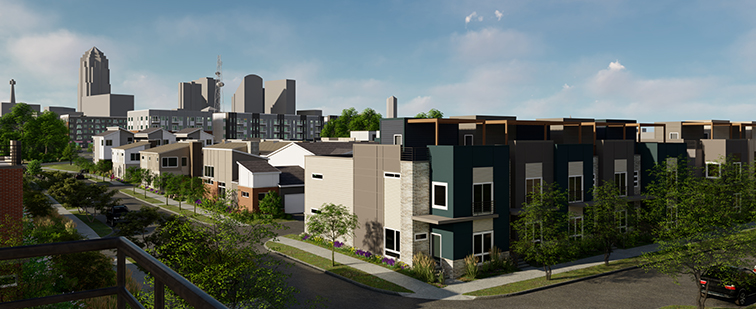Welcome to the inspiration station, literally.
The inspiration for Gray’s Station came from various neighborhoods around the country, from focus group feedback and from Hubbell’s team of experts and design partners pushing the norm of downtown living in Des Moines.
The name Gray’s Station itself is inspired by the ground’s history. Originally, the 75-acre plot was owned by Hubbell Realty Company’s founder, Fredrick Marion (F.M.) Hubbell in the late 1800’s. Years later, Hubbell would sell to one of Des Moines’ first railway companies which then became home to the Norfolk Southern Railroad for many decades. Once transportation began to transform, the lot was abandoned and left empty.
Along with the professionals at RDG Planning & Design, Hubbell’s development, multifamily, commercial and homebuilding teams came together to create the idea of an urban neighborhood in the 75 acres of desolate land. As the team explored naming ideas, the word station was used as a nod to the history and Gray’s Station was born.
Hubbell and RDG, among many other landscape, design and environmental experts, researched concepts from around the nation in similar developments in cities like Stapleton, Colorado and Mueller in Austin, Texas. These communities are centered around walkability and connectivity and both developments turned former airport land into urban neighborhoods. They mixed high-density housing, commercial, and homes with paseos and main street-style commercial districts with pedestrian-friendly trails, bike paths and pocket parks.
“We’ve come a long way downtown and we’ve done beautiful things, but what’s the next step?” said Kris Saddoris, Vice President of Multifamily Development with Hubbell. “Not only for the people who are here but also for the people we’re trying to attract: What are they looking for? What are they doing today in Denver or Portland that we can do in Des Moines?”
Gray’s Station will feature more than 1,100 housing units including rental apartments, rental townhomes and for-sale townhomes spread out through three phases. Each phase is expected to take three to five years, with an overall build-out timeline of around fifteen years. The first phase is currently underway with deliveries of the first homes expected in early 2020.
The community will add $250 million in development to the downtown core and add on another neighborhood south of MLK Jr. Parkway.
“Des Moines is bringing a beautiful, diverse population here, but I think one of the focuses we will do here, that we have not done well as a community, is family housing,” Saddoris said. “So, this will be a great place for the millennials here to stay downtown.”
The goal is to give those renting, working and playing in downtown Des Moines an option to own and purchase a home in a more urban environment.
“This area is going to be the signature urban development. A neighborhood that is taking housing to the next level in Des Moines,” said Joe Pietruszynski, Senior Vice President of Development with Hubbell.
In addition to high density housing, inspiration also came in the form of focus groups urging developers like Hubbell to add in more green space and park systems. Connectivity was a huge factor for people looking to stay downtown.
“In one of our focus groups, someone told us, ‘When you walk out of your front door, you should feel like you’re in a park.’ That’s very difficult for us to do in an urban environment, but I think we accomplished it here,” said Justin Platts, RDG Planning & Design, who developed the Gray’s Station concept with Hubbell.
Throughout the development, homeowners and visitors will find a handful of public pocket parks, community-inspired art work and bike-friendly streets. They’ll also be able to follow the Gray’s bike trail along the City of Des Moines’ wetland basin park system which will feature native plants and species in a wetland basin. This basin will filter and clean water from the city before returning it to the Raccoon River to the south.
The trail system will lead to the Gray’s Station bridge which connects with Gray’s Lake and Water Works park.
For more information and to follow the latest on development, please visit graysstation.com or our Facebook page, Gray’s Station.

